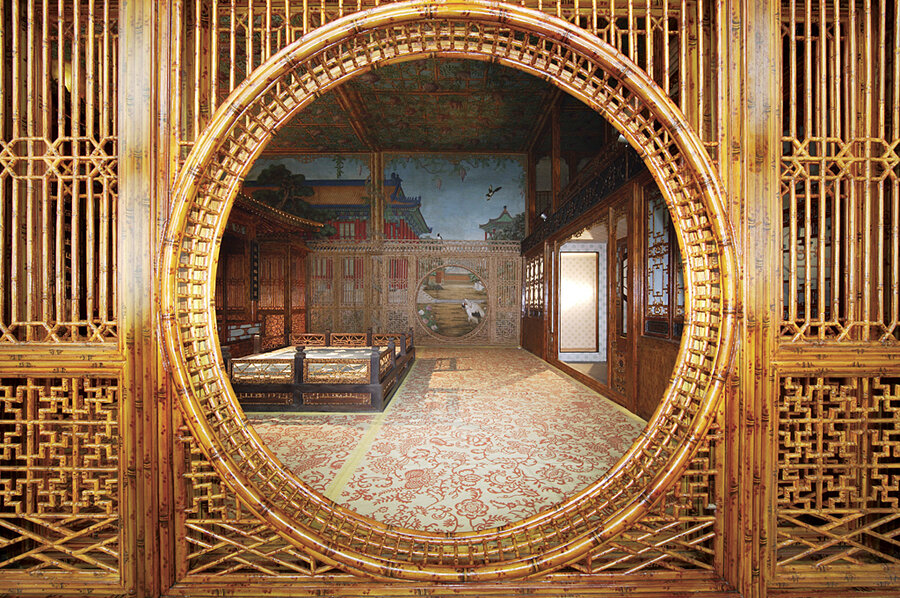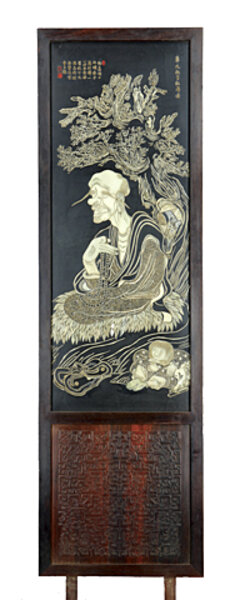Beijing treasures: a hidden world on view
Loading...
As Americans declared their independence in 1776, on the other side of the world, an introspective emperor was celebrating the completion of his opulent retirement compound in Beijing's Forbidden City.
The Qianlong Emperor spared no expense in assembling this group of 27 structures, including pavilions, gazebos, and a private theater, on two acres in the northeast corner of the Forbidden City, a fortified enclosure that was China's seat of power for 500 years.
Although he kept other palaces, the emperor intended the Qianlong Garden complex to be his personal retreat. To that end, he commissioned the finest Ching Dynasty-era craftsmen to create exquisite furnishings, carvings, screens, and wall murals.
One hundred and forty-eight years later, in 1924, the last emperor, Puyi, left the Forbidden City, sealing the gates behind him. In all that time, successive emperors had followed an edict forbidding changes to the Qianlong Garden.
Revolutions came and went. China became a Communist state and eventually opened parts of the vast Forbidden City to its citizens and tourists. But the Qianlong Garden remained closed and forgotten, asleep beneath layers of dust.
Now, the emperor's retreat is being uncovered and restored, and 90 of its furnishings have arrived in the United States for a rare showing before they are permanently reinstalled in the Qianlong Garden. "The Emperor's Private Paradise: Treasures from the Forbidden City" is on display at the Peabody Essex Museum (PEM) in Salem, Mass., and will travel to New York and Milwaukee in 2011.
IN PICTURES: Treasures from the Forbidden City
The essence of the exhibition is not about specific objects, as beautiful as they are, says Henry Ng, executive vice president of the World Monuments Fund, which is involved with the restoration. "These objects are the physical manifestation of traditional Chinese values. They help us understand the role of Confucianism, Buddhism, nature, and harmony in Chinese culture."
The emperor was a powerful military leader who expanded Chinese territory, but he was also a patron of the arts, a scholar of Confucian philosophy, and a follower of Tibetan Buddhism. His life was circumscribed within the walls of the Forbidden City and so everything he encountered re-inforced his image of himself and his nation as supreme.
"He could be compared to Louis XIV of France," says Maxwell Hearn, curator of Asian art at New York's Metropolitan Museum of Art. "The magnitude of cultural ambition, the extraordinarily embellished world, the lack of impetus to look outward. They shared those characteristics."
The Qianlong Emperor may have lived an insular life, but he knew about European culture, particularly the architecture of the Versailles Palace and the latest painting styles.
His staff included an Italian Jesuit missionary who was skilled in European painting techniques such as trompe l'oeil (employing a perspective that "fools the eye"). His court painters adopted European techniques and even subject matter, but retained their Chinese influence. One example in the exhibition involves a large painting of a Chinese domestic scene with women and children. One young woman gazes thoughtfully at her reflection in a black lacquered wall panel. Such reflective poses are unusual in Chinese paintings, says Nancy Berliner, one of the exhibition's organizers and curator of Chinese art at PEM.
READ PROFILE: Curator extraordinaire Nancy Berlinger
The emperor's literary aspirations are expressed in the poetry he wrote with mixed success, according to Hearn, and his hand is visible in the calligraphy displayed in the exhibition.
The emperor also kept meticulous notes. "We have a great trove of instructions from him," says Ms. Berliner. "He was a micromanager. His stamp is on everything."
The Qianlong Emperor's story also intersects with the long history of Western fascination with all things Chinese. As early as 1713, an Italian artist serving in the Chinese court published engravings of an imperial summer resort and gardens. These and other pictures eventually inspired the garden designs of English nobility. By the 18th century, Europeans and Americans were clamoring for Chinese silk, porcelain, tea, and new species of garden plants.
Merchants and sea captains exploited the exotic attraction of China, amassing personal fortunes and building collections of Chinese art in the mid- and late- 19th century. The PEM itself was started by a consortium of shipping magnates who had made their fortunes in the China trade.
Through everything, the Qianlong Emperor continued to add to his retreat, installing large and small works of art. He found inspiration, and probably not a little humor, in a 15-panel screen, a centerpiece of the exhibition, that depicts jade-inlay Buddhist deities with comical and contorted features. The grimaces of these disciples are meant to convey the concept that outward appearances are irrelevant, says Berliner, that even the most unworthy-seeming beings can achieve enlightenment.
An exciting discovery of the Qianlong restoration project was finding a reverse side to the Buddha deities screen, which had been installed against a wall. The side facing the wall was covered in exquisitely detailed botanic designs, an unexpected surprise. Visitors to the exhibition will be able to view both sides.
The Qianlong restoration began in 2002 and is the World Monuments Fund's largest project. One of the challenges faced by the WMF and the Palace Museum, the agency that administers the Forbidden City, was finding artists who could undertake the delicate preservation work, says Berliner. These skills had largely been lost over centuries. A cultural alert sent out across China turned up skilled craftspeople in small rural villages – some of the same villages that had supplied the Qianlong Emperor with his workers.
The restoration team hopes to create an environment so authentic that if the Qianlong Emperor were to return tomorrow, he would recognize it, says Berliner. "You can really hear his voice," she says, "in his calligraphy, in his poetry. In a sense he's all around you."
• The exhibition ends Jan. 9 and then travels to New York's Metropolitan Museum of Art and the Milwaukee Art Museum.






